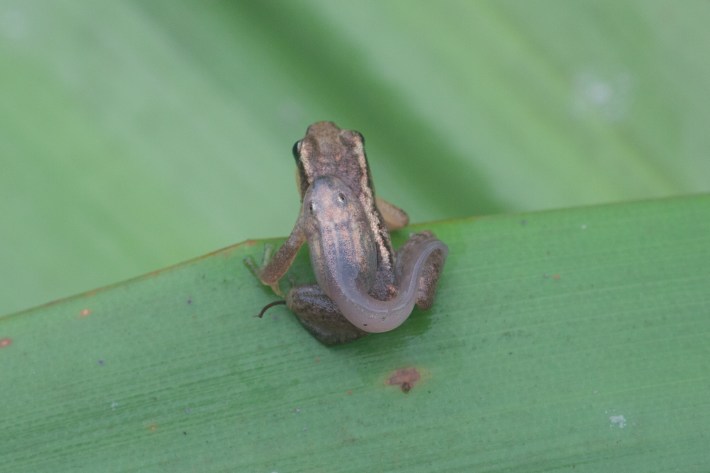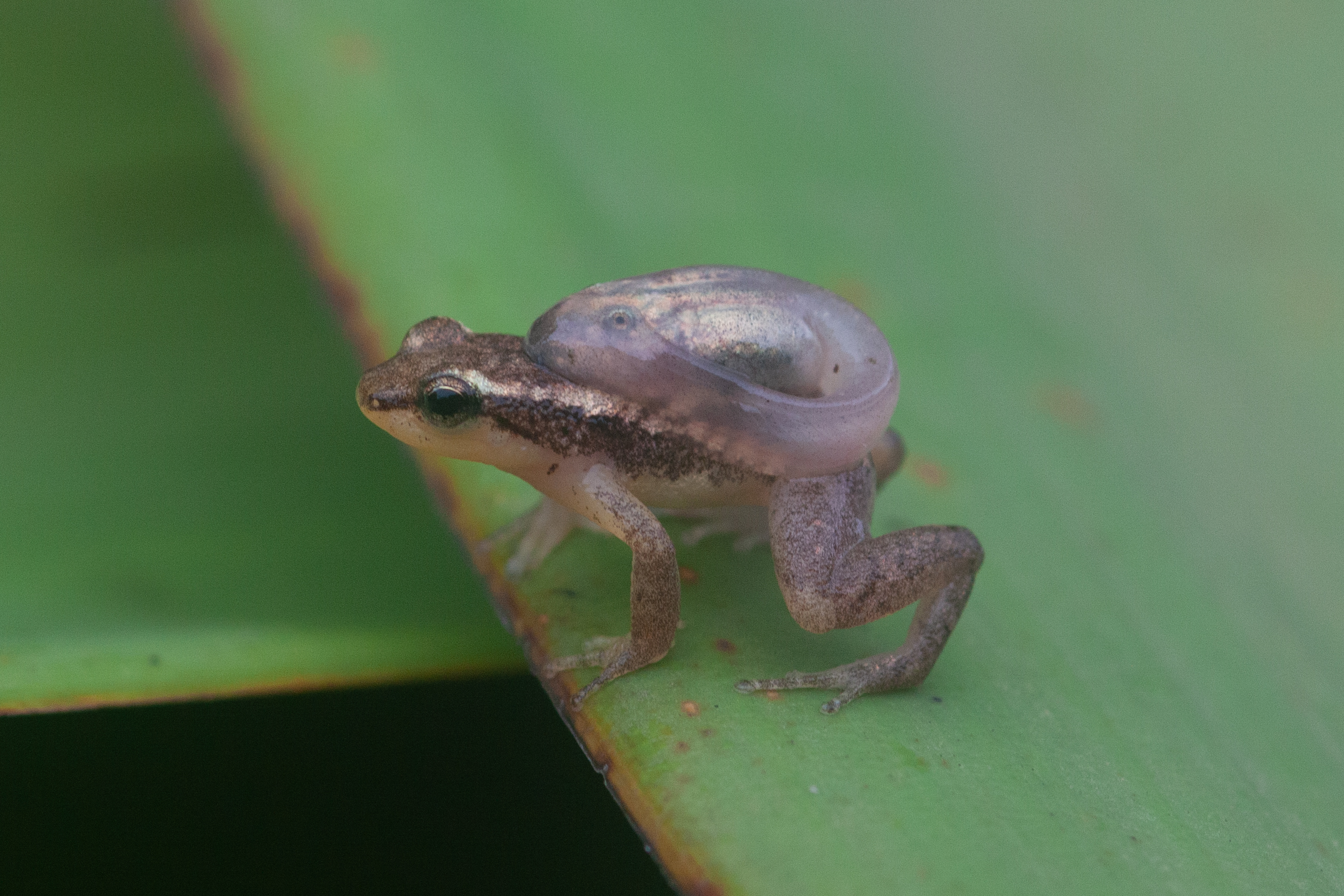In the forest glades by Guyana's Kaieteur Falls, a 741-foot waterfall that plummets in a single pour and shrouds its surroundings in perpetual mist, the ground is studded with giant tank bromeliads. The plants can grow 10 feet tall, erupting with leafy green blades and wearing their older, desiccated leaves like a hula skirt. The bromeliads almost appear to be calling to one another, with piercing peeps—deedeedee, deedeedee, deedeedee—emitted from somewhere within their clustered leaves.
These calls, of course, do not belong to the bromeliads but their most territorial occupants. Golden rocket frogs are about the size of a plump blueberry, and the females are a gleaming yellow while the males are a stately taupe. The males fiercely defend the bromeliads within their territory. The plant isn't just a shelter for the male frog and his mate—it's also a nursery. The female deposits clutches of eggs in the phytotelmata, or the tiny pools of water that collect between bromeliad leaves, and the male carries newly hatched tadpoles on his back to individual pools, where the tadpoles continue growing up and getting legs.
The parenting techniques of poison frogs, the family that encompasses golden rocket frogs, are unusually dedicated for amphibians. Ferrying tadpoles on one's back is certainly a feat, but so are the smaller, less visible decisions frog parents make to give their offspring the best chance at survival and success. In particular, male golden rocket frogs defend bromeliads with the nicest possible pools, according to a new paper in the journal Evolutionary Ecology.
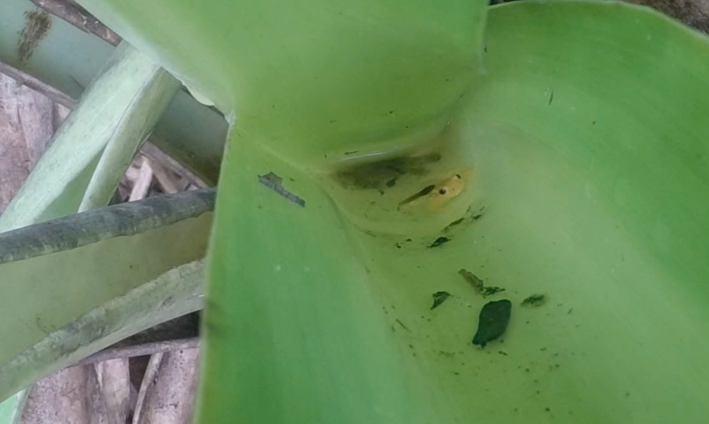
All pools are not made equal. Years ago, James Tumulty, now a biologist at the College of William & Mary, had mapped out the distribution of frogs around Kaieteur Falls. He'd noticed male golden rocket frogs were exclusively found in the giant tank bromeliads. "But then not every bromeliad is filled with frogs," Tumulty said. He began to wonder: In the eyes of the frogs, what made some bromeliads better than others?
Tumulty floated the question to Chloe Fouilloux, a researcher at the University of Wisconsin Madison and author on the paper, who was in his lab at the time. Fouilloux's background was in limnology, which is the study of lakes, but she was drawn to the idea of phytotelmata. "These leaf axils, they're like these beautiful mini little lakes," Fouilloux said. She figured she could measure the quality of each tiny nursery pool using the same measurements and techniques researchers use to study lakes.
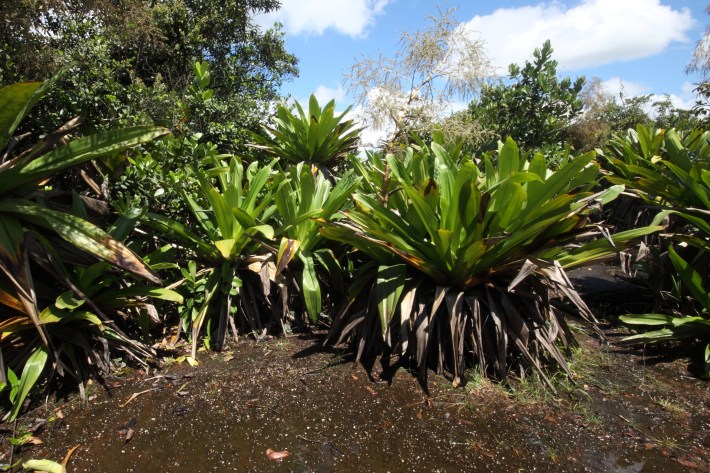
Tumulty and Fouilloux spent the summer of 2017 studying the golden rocket frogs by Kaieteur. Here, bromeliads grew so densely that overlapping leaves could act as frog bridges from one plant to another. The researchers knew each male golden rocket frog defended approximately one square meter of territory, often overseeing multiple bromeliads. The males are serious about protecting their chosen bromeliad territory. "I've seen the same two males wrestling with each other every day for a week," Tumulty said. What kind of damage can two berry-sized frogs do to each other? Not much—the frogs sort of hop on top of each other and occasionally push their heads under the other's vocal sac. "It's more of like a sumo wrestler type thing. They're not really injuring each other," Tumulty said. "But it's very physical," Fouilloux said. "And it's really cute."
Over the course of three days, the researchers studied as many of the phytotelmata as they could. They shone a light in each pool to check for cream-colored tadpoles or eggs. "You put your face into this leaf axil, but it really feels like a little well, and your face is surrounded by this kind of light green," Fouilloux said. "Sometimes you can see the little tadpoles swim up."
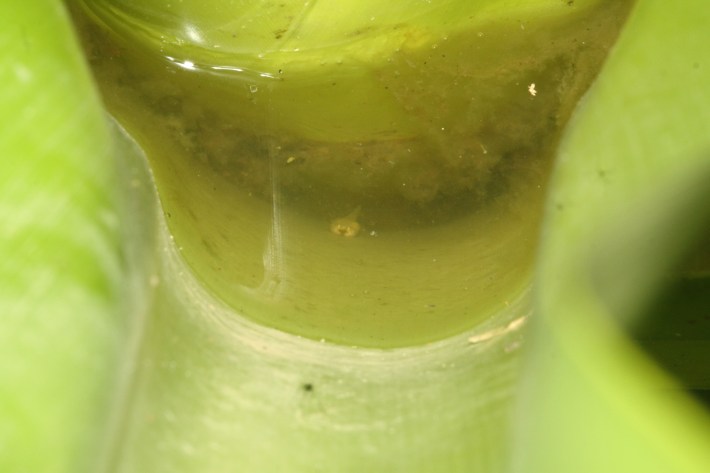
The researchers measured the volume of each pool by sucking the water into a turkey baster, and measured the dissolved oxygen and turbidity of sediment in the water. "We cut the turkey baster so it was large enough so that a tadpole, if it was sucked up, would go for a little ride and then go back into its little home," Tumulty said.
Some of the phytotelmata were filled with crystalline water, but about 30 percent of the pools were clogged with a strange, gelatinous like mucus. "Imagine if you leave Jell-O out for a day or so," Fouilloux said. "It became quite clear that, like, wow, these are really distinct little worlds that are existing here." The researchers probed these goopy pools with a stick to see if tadpoles lurked beneath the slime. The researchers did not determine what the goop was made of or why it was there, but hope to sample it the next chance they get.
Several times each week, the researchers attempted to catch and mark every frog they could find in the study site. Males were easy to track down because of their blaring calls, which reach 80 decibels about a meter away—audible even above the ambient roar of the waterfall. The leafy blades of the bromeliads can even act as megaphones, amplifying the frog's calls. But some still eluded the scientists, guarding pools in the tops of the tallest bromeliads. "These animals can really spend their entire lives on these plants," Fouilloux said. "These bromeliads are so huge, and even though they are simple plants, there's still frogs that live there that we'll probably never see," she added.

When Fouilloux returned to the states, she was still an undergrad learning how to code. She worked on the paper in the following years, picking up the analysis as she gained new skills. Her analysis revealed that tadpoles were most likely to be found near the middle leaves of a bromeliad, in pools with less of the strange mucilage. These clearer pools were also less turbid, had more dissolved oxygen, and were exposed to less light. The spatial analysis suggested these prime pools were more likely to be found inside the male's territories, often near the center, suggesting the male frogs are quite savvy about which pools to use and protect—even before they are occupied.
In his career, Tumulty has seen many poison frog dads transporting their diminutive, newly hatched tadpoles. But the golden rocket frogs may be unique in their ferrying of much larger, more adult offspring: pinky-sized tadpoles that are at least couple weeks old, if not older. "When I saw this giant tadpole, it was just an amazing, amazing moment in my science career," he said. The giant tadpole was not just impressively chunky; its girth suggested the golden rocket fathers might monitor their tadpoles for months at a time, perhaps moving their young if the conditions in their original pool deteriorate. In the years since, he's seen several other giant babies piggybacking on their dads in search of better pools. To a golden rocket frog, a baby is a baby, no matter how big.
